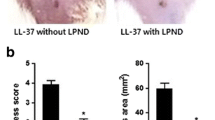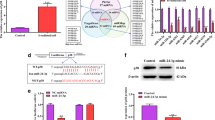Abstract
The 1064-nm Q-switched neodymium-doped yttrium aluminum garnet (Nd:YAG) laser is widely used in clinical practice. However, the effects of 1064-nm Q-switched Nd:YAG laser on skin collagen generation have not been fully elucidated. The objectives of the present study were to investigate whether the 1064-nm Q-switched Nd:YAG laser can be used for non-ablative rejuvenation and to explore the possible mechanism underlying the effects. Six-week-old SKH-1 hairless mice were irradiated by the 1064-nm Nd:YAG laser at fluences of 0, 0.5, 1, 1.5, and 2 J/cm2, respectively. The contents of hydroxyproline and hydration were detected after laser irradiation. Moreover, hematoxylin-eosin (HE) staining was preformed to evaluate the dermal thickness. Immunofluorescence was used to detect the expressions of MMP-2 and TIMP-1 in the skin after laser irradiation. Furthermore, qRT-PCR was performed to determine the expressions of TGF-β1 and Smad3. In addition, the expressions of ERK1/2, p-ERK1/2, p38, p-p38, JNK, ERK5, and collagen were evaluated by Western blotting. The results indicated that the levels of hydroxyproline, hydration, and collagen were markedly increased; both the thickness of dermal was enhanced after low dose of laser treatment. Moreover, the expression of TIMP-1 was significantly increased, whereas the expression of MMP-2 was remarkably decreased after laser irradiation. Meanwhile, TGF-β1, Smad3, p-ERK1/2, p-P38, and JNK productions were significantly enhanced in irradiated group compared with the ones non-irradiated. Nevertheless, no significant changes were observed in the expression of ERK5 after irradiation. In summary, our study demonstrated that Q-switched 1064-nm Nd:YAG laser can induce collagen generation, at least in part, through activating TGF-β1/Smad3/MAPK signaling pathway.





Similar content being viewed by others
References
Farage MA, Miller KW, Elsner P, Maibach HI (2013) Characteristics of the aging skin. Adv Wound Care (New Rochelle) 2:5–10
Tao L, Wu J, Qian H, Lu Z, Li Y, Wang W, Zhao X, Tu P, Yin R, Xiang L (2015) Intense pulsed light, near infrared pulsed light, and fractional laser combination therapy for skin rejuvenation in Asian subjects: a prospective multi-center study in China. Lasers Med Sci 30:1977–1983
Yaar M, Gilchrest BA (2007) Photoaging: mechanism, prevention and therapy. Br J Dermatol 57:874–887
Goldberg DJ, Silapunt S (2001) Histologic evaluation of a Q-switched Nd: YAG laser in the nonablative treatment of wrinkles. Dermatol Surg 27:744–746
Zhou ZQ, Yang RY (2015) Clinical progresses on non-surgical facial rejuvenation. J Pract Dermatol 8:438–444
Goldberg DJ, Metzler C (1999) Skin resurfacing utilizing a lowfluence Nd: YAG laser. J Cut laser Ther 1:23–27
do Rhee Y, Cho HI, Park GH, Moon HR, Chang SE, Won CH, Jung JM, Park KY, Lee MW, Choi JH, Moon KC, Lee DC, Goo B (2016) Histological and molecular analysis of the long-pulse 1064-nm Nd: YAG laser on irradiation the ultraviolet-damaged skin of hairless mice: In association with pulse duration change. J Cosmet Laser Ther 18:16–21
Dang YY, Liu B, Liu LX, Ye XY, Bi XL, Zhang Y, Gu J (2011) The 800-nm diode laser irradiation induces skin collagen synthesis by stimulating TGF-β/Smad signaling pathway. Lasers Med Sci 26:837–843
Huang JH, Luo X, Lu JY, Chen J, Zuo CX, Xiang YP, Yang SB, Tan L, Kang J, Bi ZG (2011) IPL irradiation rejuvenates skin collagen via the bidirectional regulation of MMP-1 and TGF-β1 mediated by MAPKs in fibroblasts. Lasers Med Sci 26:381–387
Yang B, Ji C, Kang J, Chen W, Bi Z, Wan Y (2009) Trans-zeatin inhibits UVB-induced matrix metalloproteinase-1 expression via MAP kinase signaling in human skin fibroblasts. Int J Mol Med 23:555–560
Kocic H, Arsic I, Stankovic M, Tiodorovic D, Ciric V, Kocic G (2017) Proliferative, anti-apoptotic and immune-enhancing effects of L-arginine in culture of skin fibroblasts. J Biol Regul Homeost Agents 31:667–672
Ryu AR, Lee MY (2017) Chlorin e6-mediated photodynamic therapy promotes collagen production and suppresses MMPs expression via modulating AP-1 signaling in P. acnes-stimulated HaCaT cells. Photodiagn Photodyn Ther 20:71–77
Kunimatsu R, Gunji H, Tsuka Y, Yoshimi Y, Awada T, Sumi K, Nakajima K, Kimura A, Hiraki T, Abe T, Naoto H, Yanoshita M, Tanimoto K (2018) Effects of high-frequency near-infrared diode laser irradiation on the proliferation and migration of mouse calvarial osteoblasts. Lasers Med Sci 33: 959–966
Shin MK, Lee JH, Lee SJ, Kim NI (2012) Platelet-rich plasma combined with fractional laser therapy for skin rejuvenation. Dermatol Surg 38:623–630
Li ZQ, Zhuang L, Feng ZC, Qi QC, Zhong H, Ma WY (2013) Analysis of the endoplasmic reticulum stress in non-ablative skin rejuvenation using Q-switched 1064 nm Nd: YAG laser. Chin J Plast Surg 29:113–116 (in Chinese)
Chan HH, Lam LK, Wong DS, Wei WI (2003) Role of skin cooling in improving pateint tolerability of Q-switched alexandrite (QS Alex) laser in nevus of Ota treatment. Lasers Surg Med 32:148–151
Nikolaou VA, Stratigos AJ, Dover JS (2005) Nonablative skin rejuvenation. J Cosmet Dermatol 4:301–307
Oh J, Kim N, Seo S, Kim IH (2010) Alteration of extracellular matrix modulators after nonablative laser therapy in skin rejuvenation. Br J Dermatol 157:306–310
Cao Y, Huo R, Feng Y, Li Q, Wang F (2011) Effects of intense pulsed light on the biological properties and ultrastructure of skin dermal fibroblasts: potential roles in photoaging. Photomed Laser Surg 29:327–332
Alster T (2003) Laser scar revision: comparison study of 585-nm pulsed dye laser with and without intralesional corticosteroids. Dermatol Surg 29:25–29
Hinz B (2007) Formation and function of the myofibroblast during tissue repair. J Invest Dermatol 127:526–537
Dang Y, Ye X, Weng Y, Tong Z, Ren Q (2010) Effects of the 532-nm and 1064-nm Q-switched Nd:YAG lasers on collagen turnover of cultured human skin fibroblasts: a comparative study. Lasers Med Sci 25:719–726
Nishimoto S, Nishida E (2006) MAPK signalling: ERK5 versus ERK1/2. EMBO Rep 7:782–786
Brennan M, Bhatti H, Nerusu KC, Bhagavathula N, Kang S, Fisher GJ, Varani J, Voorhees JJ (2003) Matrix metalloproteinase-1 is the major collagenolytic enzyme responsible for collagen damage in UVirradiated human skin. Photochem Photobiol 78:43–48
Gomes LR, Terra LF, Wailemann RA, Labriola L, Sogayar MC (2012) TGF-β1 modulates the homeostasis between MMPs and MMP inhibitors through p38 MAPK and ERK1/2 in highly invasive breast cancer cells. BMC Cancer 12:26
Lin X, Duan X, Liang YY, Su Y, Wrighton KH, Long J, Hu M, Davis CM, Wang J, Brunicardi FC, Shi Y, Chen YG, Meng A, Feng XH (2006) PPM1A functions as a Smad phosphatase to terminate TGFβ Signalin. Cell 125:915–928
Lake D, Corrêa SA, Müller J (2016) Negative feedback regulation of the ERK1/2 MAPK pathway. Cell Mol Life Sci 73:4397–4413
Funding
This work was performed in Department of Dermatology, the first affiliated hospital of Kunming medical university and supported by the National Natural Science Foundation of China (81560507) and the Yunnan Provincial Department of Science and Technology-Kunming Medical University Joint Research Fund for Applied Basic Research (2014FB023).
Author information
Authors and Affiliations
Corresponding author
Ethics declarations
Conflict of interest
This authors declare that they have no conflict of interest.
Ethical approval
This study received ethical approval from the first affiliated hospital of Kunming medical university ethics committee (approval no. 2017-06).
Rights and permissions
About this article
Cite this article
Yang, Z., Xiang, H., Duan, X. et al. Q-switched 1064-nm dymium-doped yttrium aluminum garnet laser irradiation induces skin collagen synthesis by stimulating MAPKs pathway. Lasers Med Sci 34, 963–971 (2019). https://doi.org/10.1007/s10103-018-2683-6
Received:
Accepted:
Published:
Issue Date:
DOI: https://doi.org/10.1007/s10103-018-2683-6




